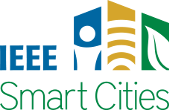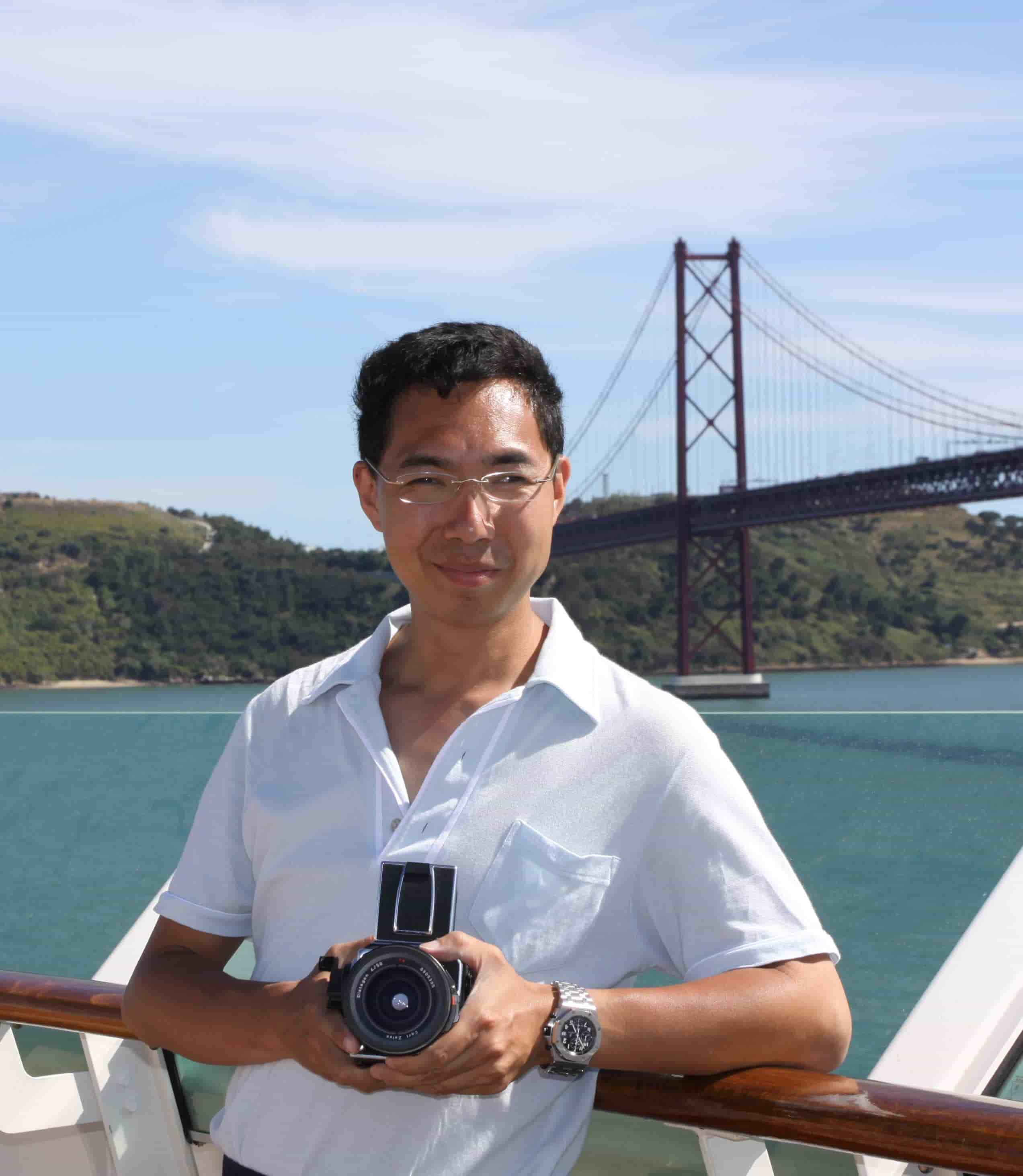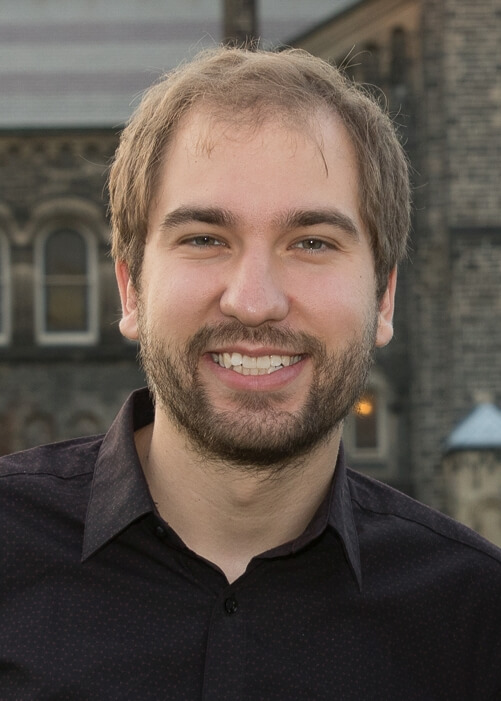STEM Vs STEAM Approach Dilemma in the Innovation Ecosystem for Smart Cities Sustainability.
Written by Isaac Wainaina, Kithinji Muriungi, Kiyeng Chumo, and David Mulongo
Innovation, entrepreneurship, critical thinking, and creativity thrive in a chaotic environment where experimentation is an important key in shaping a smart city where imagination is the limit. Therefore, in addition to STEM (Science, Technology, Engineering, and Mathematics) that essentially comprises mathematical formulae, scientific and engineering principles, there is a need to bring in the artistic side of life to achieve a holistic view in developing various applications for people in a smart city. Arts complement STEM-based innovations hollistically.
The future of sustainable smart cities will highly depend on the STEAM (Science, Technology, Engineering, Arts, and Mathematics) approach for optimal products and service delivery. The imbalance in the STEM and STEAM professional careers requires an intentional focus on embracing the STEAM approach to support most citizens and key stakeholders within the smart city ecosystem. Great STEM inventors and innovators have consistently demonstrated strong support for arts, making their work a masterpiece. Leonardo da Vinci and Steve Jobs are great examples of iconic engineers with great holistic minds. STEM is undoubtedly vital. In spite of this, focusing on it limits imagination's critical component for supporting sustainable development. Applying the STEAM approach to developing sustainable innovations in smart cities is convenient instead of working in STEM and arts silos.
Introduction
STEM is a learning approach that integrates Science, Technology, Engineering, and Mathematics, while STEAM refers to STEM that incorporates an 'A' for the Arts field [1]. These approaches help guide the student's learning, inquiry, thought and communication process. STEM emphasizes hard technical-scientific, technological, engineering, and mathematical principles and skills, while STEAM leverages both hard technical and soft non-technical skills blended by the arts. When looking at STEM and STEAM, the similarities and differences lie in how both approach scientific concepts. Technology-based innovations are disrupting almost everything. The right technologies are taking over most repetitive, predictive, and descriptive tasks, requiring either high speed or accuracy and do not necessarily require human intervention. In addition, Gartner predicts that more human-like systems with robotics-powered artificial intelligence (AI) systems than ever before, 80% of the project management tasks will be taken by AI by 2030 [2]. Therefore, as technology takes over most jobs, there is an increasing demand for people with soft skills. This calls for STEM professionals to be well-rounded for growth and sustainability of innovations targeting the smart cities ecosystems.
The Why: Problem Statement
Focusing on STEM at the expense of humanities and arts may result in a decremental effect on innovation and creativity. By pivoting STEM to STEAM, innovation, creativity, and entrepreneurship can be attained in such a way that children can be equipped with adequate skills for taking part in the development of various applications and to contribute to the society through their skills learned.
Despite the efforts in championing STEAM, STEM experts still argue that a focus on STEM makes specialization easy [3]. Therefore, there is an emphasis on qualitative skills, contrasting with STEAM which focuses on quantitative skills. It can be argued that focusing on STEM overlooks the role played by the STEAM of offering a multidisciplinary approach and opening the individuals to broader imagination possibilities. STEAM makes the sustainable development of the innovation ecosystem possible due to its emphasis on the "real world," factoring in other concepts not explained in STEM. As a result, this gives STEM another possibility that is very critical in DIY and MakerSpace: human-centred designs. In addition, it encourages continuous innovation through customer-centric development approaches. STEAM also gives the actual working mechanism in an innovation project-based engagement that brings in different stakeholders in STEM and non-STEAM. The great essence of STEAM is the emphasis on teamwork, which is significant in building and career development in smart cities' ecosystems.
Pew Research Center states that STEM jobs have grown 79% since the 1990s, fueled by more than 52% of the parents predicting an increase in employment over the next decades [2]. Similarly, LinkedIn stated in 2018 that 57% of senior executives value soft skills more than hard technical skills. In 2019, LinkedIn reported that the top companies prioritize collaboration, creativity, and persuasion while hiring. While a report by Emerson showed a STEM worker shortage in the U.S., there is a need to balance the required STEM expertise through STEAM since both are critical in the entry, specialized, and expertise levels in the professional career journey. Besides, while only 37% have STEM degrees, 63% have degrees in other, non-STEM fields. According to the Commission of University Education (CUE) in Kenya [4], less than 12% of graduates major in STEM. In 2017-2018, 33% graduated in the arts and humanities, and another 33% graduated in business and administration fields.
Models and Theories
Design Thinking Methodologies are user-centred approaches that drive innovation by integrating user needs and technology. They follow a specific flow that is customer-centric, hands-on, and includes rapid prototyping in its process. The human-centred design encourages the STEAM approach by promoting product design and development with an understanding of the person experiencing the problem. These are essential for STEAM projects in integrating the 'Arts' aspect in building sustainable smart cities.
Considerable efforts in the STEAM approach have produced various theories and models [5]. Instrumental and Pedagogical rhetoric presents the implementation of the thought process to feasible problems and the integration of arts into STEM fields in terms of content and learning context, as illustrated below.
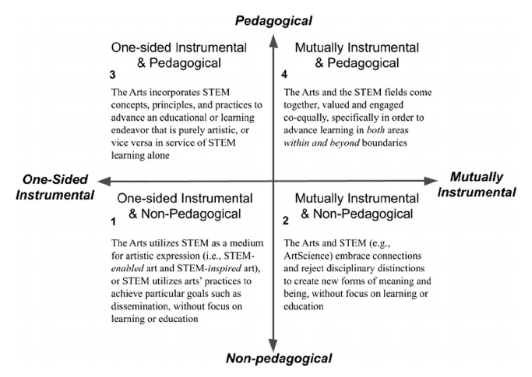
Fig 1. Instrumental and Pedagogical Theories of STEAM
Yakman's model states that STEAM is a science and technology: all based on mathematical elements, interpreted through engineering and the arts [5]. It includes the "A" for arts+design, incorporating liberal arts to achieve the interdisciplinary framework. As applied in Korea, the Wheel Model introduces Humanities (History, Geography, and Bibliography) in its multidisciplinary system [6]. It encourages human-centred projects by using conventional sciences as a medium to bridge STEAM and Humanities.
Scenarios
STEAM encourages and nurtures collaboration while factoring in STEM integration at its core concepts and practices through arts [7]. For example, STEAM integrates data science concepts through visualizations and fine art imagery to quickly understand the STEM concepts by technical and non-technical audiences in the innovation ecosystem. Such integrations are critical, especially when arts professionals innovate in areas requiring 3D concepts like Virtual-Augmented Reality (VR/AR), and mixed reality.
MRI for kids presents a perfect scenario for the application of STEAM. The Adventure Series Scanner for GE Healthcare is an innovation by Doug Dietz, an MRI engineer [8]. He discovered the discomfort and flight response caused by the MRI scan of a young girl waiting for the process. He gathered a team that transformed the experience in the pediatric department by creating adventures using paints, lights, scents, and imagination. The redesign contributed to only 10% of the patients requiring sedation instead of 80% before the innovation. Ambient Experience solutions, including the Dutch Masters theme, have made use of art and music to help calm patients during MRI examinations [9]. The artistic paintings and sketches relax the mood while the personalized music distracts the patient from their fears.
Steam and Sustainability of Smart Cities
The sustainability of smart cities is achieved when there is citizen’s quality of life, social equity, economic vitality, and conservation of natural resources and the environment [10]. Sustainable innovations must meet these requirements to ensure relevance in the smart city ecosystem. Building innovation in sustainable smart cities requires an artistic view to be incorporated into STEM to achieve the holistic STEAM approach [11]. STEAM is a key driver for sustainability across the environmental, social, economic, and technological aspects of innovation. It contributes to feasible and reliable decisions in the e-governance and liveability of smart cities.
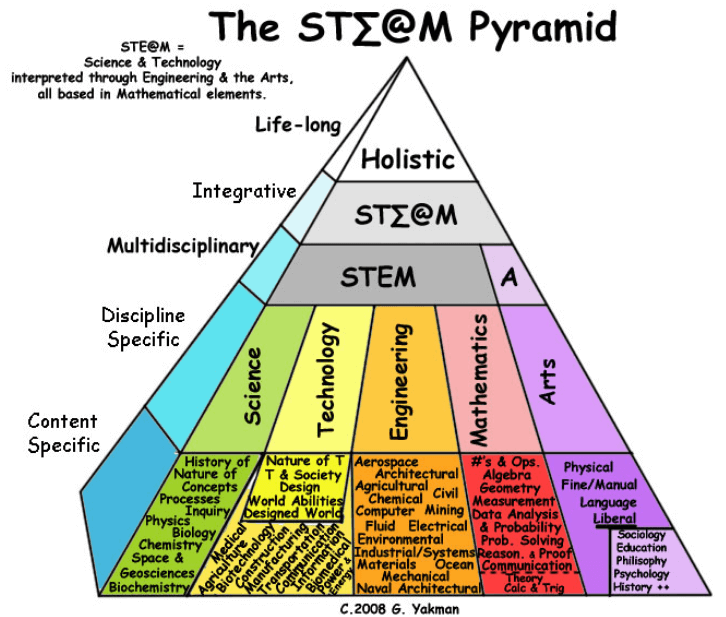
Fig 2. Yakman’s STEAM Pyramid Model
There is a need to incorporate 21st century skills into the innovation ecosystem to achieve holistically efficient products, services and experiences [12]. These include learning, literacy and life skills. The four C's of learning skills are critical thinking, creativity, collaboration and communication. Literacy skills are categorized as information, media and technology literacy. Life skills include flexibility, leadership, initiative, productivity, and social skills. These contribute to soft skills such as imagery, artistic communication, and problem-solving.
Emerging technologies such as Virtual & Augmented Reality (VR/AR), 3D graphics and modelling, Artificial Intelligence - Natural Language Processing (NLP), Video/Audio, User Interface/Experience (UI/UX) attract designers and developers who even do not have a STEM-based background. It emphasizes the importance of the holistic aspect of modern innovations. Collaboration is an essential factor in building smart cities [13]. Consequently, we should embrace convergent skills across different roles and responsibilities. The goal is to move from a specific to a multidisciplinary approach to encourage collaboration in the various fields that address all aspects of sustainable smart cities.
Conclusion
The holistic view of STEM, as demonstrated in STEAM, improves and promotes the innovation ecosystem for sustainable smart cities. Smart cities are designed for tech-savvy and non-technical populations who consume the services. It necessitates having the users' minds and perspectives in building new solutions and products. Innovations must remain relevant even beyond time by incorporating the changing demands of the city. The hard-technical skills deliver intelligent solutions, while the soft non-technical skills deliver the sustainability aspect of smart cities. This, therefore, encourages the STEAM approach compared to the STEM in the innovation ecosystem for smart cities' sustainability.
References
- Marín-Marín, JA., Moreno-Guerrero, AJ., Dúo-Terrón, P. et al. STEAM in education: a bibliometric analysis of performance and co-words in Web of Science. IJ STEM Ed 8, 41 (2021). https://doi.org/10.1186/s40594-021-00296-x
- "Comparing STEM vs. STEAM: Why the Arts Make a Difference | UCF Online", UCF Online, 2022. [Online]. Available: https://www.ucf.edu/online/engineering/news/comparing-stem-vs-steam-why-the-arts-make-a-difference/.
- W. Young, "From STEM to STEAM: Why the Arts have a place in Tech", LinkedIn, 2015. [Online]. Available: https://www.linkedin.com/pulse/from-stem-steam-why-arts-have-place-tech-walker-young/.
- C. Mwadinze, Teachers Updates, 2021. [Online]. Available: https://teachersupdates.co.ke/university/low-number-of-stem-graduates-from-local-universities-lags-kenya-behind-other-economies-kenya-economic-update-reports/.
- Mejias et al., "The trouble with STEAM and why we use it anyway", Science Education, vol. 105, no. 2, pp. 209-231, 2021. Available: 10.1002/sce.21605.
- Pyoung Won Kim. The Wheel Model of STEAM Education Based on Traditional Korean Scientific Contents. Eurasia Journal of Mathematics, Science & Technology Education, 2016, 12(9), 2353-2371 https://www.ejmste.com/download/the-wheel-model-of-steam-education-based-on-traditional-korean-scientific-contents-4605.pdf.
- R. Videla, C. Aguayo and T. Veloz, "From STEM to STEAM: An Enactive and Ecological Continuum", Frontiers in Education, vol. 6, 2021. Available: 10.3389/feduc.2021.709560.
- R. Phillips, "Positive Art News – Creativity Turns Scary MRI Scanner For Kids Into An Adventure", Healing Power of Art & Artists, 2022. [Online]. Available: https://www.healing-power-of-art.org/positive-art-news-creativity-turns-scary-mri-scanner-for-kids-into-an-adventure/.
- "Using the power of art and music to improve MRI experience", Philips, 2022. [Online]. Available: https://www.philips.com/a-w/about/news/archive/blogs/innovation-matters/using-the-power-of-art-and-music-to-improve-mri-experience.html.
- "Stem Vs Steam", Dabble PlayArt, 2022. [Online]. Available: https://dabbleplayart.com/blogs/creativity-in-kids/stem-vs-steam.
- G. Yakman, "STEAM Education: an overview of creating a model of integrative education", Researchgate, 2008. [Online]. Available: https://www.researchgate.net/publication/327351326_STEAM_Education_an_overview_of_creating_a_model_of_integrative_education.
- B. Stauffer, "What Are 21st Century Skills?", Aeseducation.com, 2022. [Online]. Available: https://www.aeseducation.com/blog/what-are-21st-century-skills.
- A. Toli and N. Murtagh, "The Concept of Sustainability in Smart City Definitions", Frontiers in Built Environment, vol. 6, 2020. Available: 10.3389/fbuil.2020.00077.
This article was edited by Bernard Fong
To view all articles in this issue, please go to April 2022 eNewsletter. For a downloadable copy, please visit the IEEE Smart Cities Resource Center.

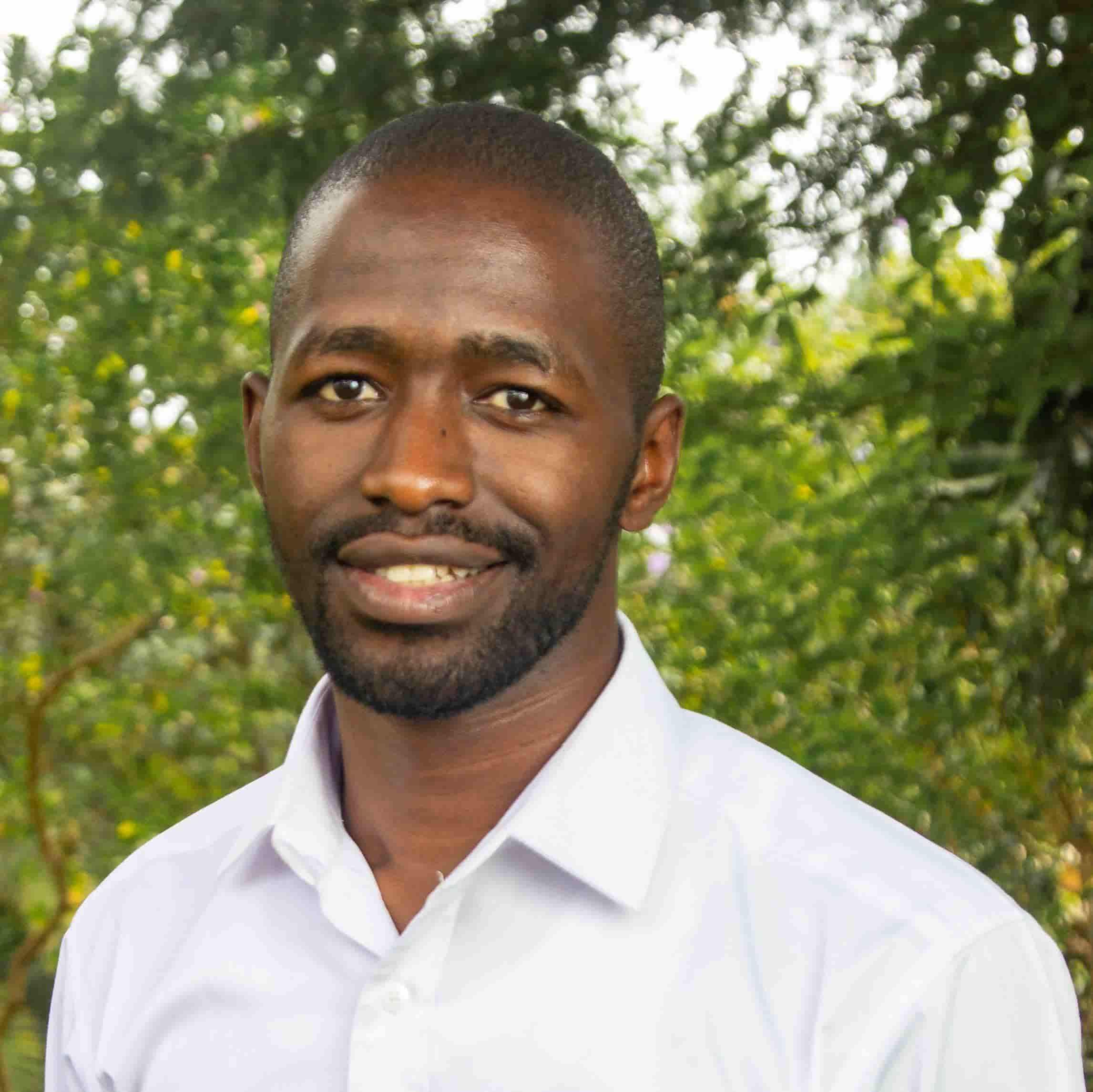


To have the eNewsletter delivered monthly to your inbox, join the IEEE Smart Cities Community.
Past Issues
To view archived articles, and issues, which deliver rich insight into the forces shaping the future of the smart cities. Older eNewsletter can be found here. To download full issues, visit the publications section of the IEEE Smart Cities Resource Center.

